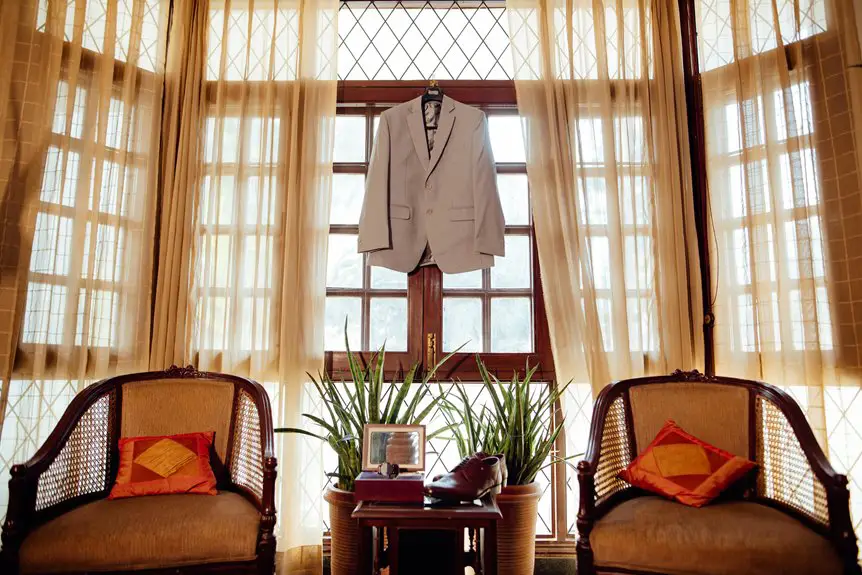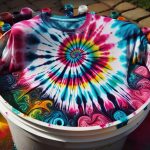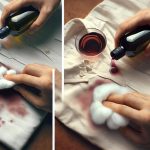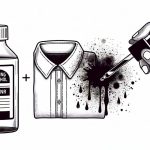To remove jean dye transfer from light-colored upholstery, act quickly by gently blotting excess dye with a dry cloth. Test a hidden fabric spot first, then use a mild detergent mixed with warm water to blot the stain from edges inward without over-wetting. For stubborn spots, try white vinegar or rubbing alcohol on a cotton ball. Avoid harsh scrubbing to protect fibers. Taking these steps helps prevent permanent staining, and with a few more tips, you can keep your upholstery looking fresh.
Table of Contents
Key Takeaways
- Immediately blot the jean dye stain with a clean, dry cloth to absorb excess pigment without rubbing or spreading it.
- Test a hidden upholstery spot with water, then gently dab the stain from outer edges inward using a dampened white cloth.
- Use a mild detergent solution or white vinegar on a soft cloth to blot the stain, rinsing residue carefully with water afterward.
- Avoid saturating the fabric and allow the area to air dry before repeating cleaning or trying stronger solutions like rubbing alcohol.
- Prevent future stains by washing jeans before use, applying fabric protector spray on upholstery, and using slipcovers on light furniture.
Understanding Jean Dye and Its Effects on Upholstery
Have you ever wondered why jean dye stains your upholstery so stubbornly? The deep indigo pigments in denim are designed to resist fading, which makes them cling tightly to fabrics like your sofa or chair.
When the dye transfers, it seeps into the upholstery’s fibers, especially on light-colored materials, leaving a noticeable, often tough-to-remove mark. This happens because jean dye isn’t water-soluble; it’s created to withstand washing and wear.
As a result, standard cleaning methods mightn’t work effectively. Understanding this helps you realize why prompt and proper treatment is essential. The longer the dye sits, the more it bonds with the fabric, making removal increasingly difficult.
Identifying the Type of Upholstery Fabric
Since jean dye reacts differently depending on the fabric, knowing what kind of upholstery you’re dealing with helps you choose the right removal method.
Start by checking the manufacturer’s tag, usually found under cushions or on the frame, which tells you the fabric type and cleaning codes like W, S, WS, or X.
Check the manufacturer’s tag under cushions or on the frame for fabric type and cleaning codes.
If there’s no tag, test a hidden spot with a little water—natural fibers like cotton absorb it quickly, while synthetic ones repel moisture.
Feel the fabric: smooth and silky suggests synthetics, while rougher textures hint at natural fibers.
Identifying whether your upholstery is cotton, polyester, microfiber, or a blend influences which cleaning solutions you can safely use without damaging the fabric or setting the stain further.
Immediate Steps to Take After Dye Transfer
Although it can be frustrating, acting quickly after dye transfer is essential to prevent the stain from setting.
First, gently blot the affected area with a clean, dry cloth to absorb any excess dye—avoid rubbing, as that can spread the stain.
Next, test a small, hidden section of the upholstery with plain water to verify it won’t cause damage or discoloration.
If safe, lightly dab the stain with water using a clean cloth, working from the outside in to prevent spreading.
Avoid saturating the fabric, as too much moisture can cause the dye to seep deeper.
Finally, keep the area well-ventilated and allow it to air dry before attempting any further cleaning steps to avoid embedding the stain.
Preparing Your Cleaning Supplies
Gathering the right cleaning supplies is essential for effectively tackling jean dye transfer without damaging your fabric. Start with a soft white cloth or sponge to avoid color bleeding.
Use a soft white cloth or sponge to safely remove jean dye transfer without causing color bleeding.
Have a small bowl ready for mixing cleaning solutions. You’ll also need a spray bottle for applying water or cleaning agents evenly. Make sure to use gloves to protect your hands from harsh chemicals.
Keep a clean towel nearby for blotting excess moisture and lifting stains gently. Avoid abrasive brushes or rough sponges, as they can damage upholstery fibers.
Finally, have a mild, color-safe cleaning solvent or detergent on hand—but don’t mix anything yet. Preparing these supplies ahead lets you act quickly and carefully, increasing your chances of removing the dye transfer effectively.
Using Mild Detergent Solutions to Lift Dye Stains
Anyone dealing with jean dye transfer can start by mixing a mild detergent solution to gently lift the stains.
Combine a few drops of mild liquid detergent with warm water in a clean bowl. Dampen a white cloth with this solution, then gently blot the stained area—don’t rub, as this can spread the dye.
Work from the outer edges toward the center to contain the stain. After blotting, use a fresh cloth dampened with plain water to remove detergent residue. Blot dry with a clean towel.
Repeat this process as needed, but avoid over-wetting the upholstery. This method helps break down and lift the dye transfer without harsh chemicals, making it safe for light-colored fabrics.
Be patient and gentle to prevent damage.
Applying Vinegar and Baking Soda for Stubborn Stains
When mild detergent solutions don’t fully remove jean dye transfer, vinegar and baking soda can tackle stubborn stains effectively.
First, mix equal parts white vinegar and water in a spray bottle. Lightly spray the stained area, being careful not to saturate the upholstery. Let it sit for about 5 minutes to break down the dye.
Next, sprinkle baking soda over the damp spot. The baking soda will help lift the stain and neutralize odors. Gently rub the mixture into the fabric using a soft brush or cloth.
After a few minutes, blot the area with a clean, damp cloth to remove residue. Repeat if necessary, but avoid over-wetting. This natural combo often restores your upholstery without harsh chemicals.
Testing Cleaning Methods on Hidden Areas
Before you apply any cleaning solution, test it on a hidden area of your fabric to avoid damage.
Use gentle, safe cleaners and watch for any color changes or fabric weakening.
This simple step helps guarantee your stain removal won’t cause new problems.
Spot Testing Techniques
Although removing jean dye transfer can be tricky, testing your cleaning method on a hidden area helps prevent further damage. Start by choosing a small, inconspicuous spot on your upholstery. Apply a small amount of the cleaning solution, wait for 10-15 minutes, then blot with a clean cloth. Check for discoloration or fabric damage before proceeding to larger areas.
| Step | Action | Purpose |
|---|---|---|
| 1 | Select hidden spot | Avoid visible damage |
| 2 | Apply small solution amount | Test reaction |
| 3 | Wait 10-15 minutes | Allow solution to act |
| 4 | Blot and inspect | Detect fabric changes |
This method guarantees you safely remove stains without harming your upholstery’s appearance.
Safe Cleaning Solutions
After confirming your cleaning solution won’t harm the fabric, focus on choosing safe options that effectively tackle jean dye transfer.
Start with mild solutions like diluted dish soap or a mixture of white vinegar and water. These are gentle yet effective at breaking down dye stains without damaging upholstery fibers.
Always test your chosen cleaner on a hidden spot, such as under a cushion or the underside of the fabric, to guarantee it doesn’t cause discoloration or fiber damage.
Apply a small amount, wait a few minutes, then blot gently and check for any adverse effects. If the test spot holds up well, proceed with cleaning the stained area.
Avoiding Common Mistakes When Treating Upholstery Stains
When treating upholstery stains, you’ll want to steer clear of common mistakes that can make the problem worse or even damage the fabric.
First, avoid scrubbing aggressively; it can push the dye deeper or fray fibers. Instead, blot gently with a clean cloth.
Don’t use bleach or harsh chemicals unless the fabric care label explicitly allows it, as these can discolor or weaken upholstery.
Avoid soaking the fabric—excess moisture can cause mold or water stains.
Test any cleaner on a hidden area first to check for colorfastness.
Also, resist the urge to rush; let cleaning solutions sit long enough to work but don’t leave them on too long.
Tips for Preventing Future Jean Dye Transfers
To prevent jean dye transfers from happening again, you need to take proactive steps that protect your upholstery and clothing.
Start by being mindful of when and where you sit while wearing new or dark jeans. Here are some practical tips to help you avoid future stains:
- Wash new jeans several times before wearing them on light-colored furniture.
- Apply a fabric protector spray on your upholstery to repel dyes and spills.
- Use slipcovers or throws on your furniture when wearing jeans prone to bleeding.
- Clean any small dye spots immediately to prevent them from setting in.
Frequently Asked Questions
Can Professional Upholstery Cleaning Remove Old Jean Dye Stains?
You can often rely on professional upholstery cleaning to tackle old jean dye stains. They use specialized techniques and products that you might not have at home, increasing the chances of successfully removing those stubborn marks.
Are There Any Commercial Products Specifically for Jean Dye Removal?
You’d think the ocean itself couldn’t wash out jean dye, but luckily, some commercial products like OxiClean and color-safe bleach are designed specifically for stubborn dye stains. Just test a hidden spot before treating!
How Long Does It Take for Dye Transfer to Set in Upholstery?
Dye transfer can start setting in upholstery within minutes to a few hours, depending on fabric and dye type. The longer you wait, the harder it gets to remove, so act quickly to prevent permanent stains.
Is It Safe to Use Bleach on Light-Colored Upholstery?
You shouldn’t use bleach on light-colored upholstery since it can damage the fabric or cause discoloration. Instead, try a mild detergent or upholstery cleaner. Always test a small hidden area first to avoid damage.
Can Jean Dye Transfer Cause Permanent Fabric Discoloration?
Jean dye can cause stubborn, stubborn stains that sometimes lead to permanent fabric discoloration. If you don’t act quickly, the color might cling and create a lasting, lasting mark on your upholstery’s light, lovely layers.
- Does Chiffon Fabric Stink - July 15, 2025
- Does Chiffon Fabric Affect the Economy - July 15, 2025
- Does Cotton Fabric Have a Nap - July 15, 2025







